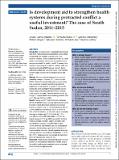| dc.description.abstract | Introduction Is achievement of Sustainable Development Goal (SDG) 16 (building peaceful societies) a precondition for achieving SDG 3 (health and well-being in all societies, including conflict-affected countries)? Do health system investments in conflict-affected countries waste resources or benefit the public’s health? To answer these questions, we examine the maternal, newborn, child and reproductive health (MNCRH) service provision during protracted conflicts and economic shocks in the Republic of South Sudan between 2011 (at independence) and 2015.
Methods We conducted two national cross-sectional probability surveys in 10 states (2011) and nine states (2015). Trained state-level health workers collected data from households randomly selected using probability proportional to size sampling of villages in each county. County data were weighted by their population sizes to measure state and national MNCRH services coverage. A two-sample, two-sided Z-test of proportions tested for changes in national health service coverage between 2011 (n=11 800) and 2015 (n=10 792).
Results Twenty-two of 27 national indicator estimates (81.5%) of MNCRH service coverage improved significantly. Examples: malaria prophylaxis in pregnancy increased by 8.6% (p<0.001) to 33.1% (397/1199 mothers, 95% CI ±2.9%), institutional deliveries by 10.5% (p<0.001) to 20% (230/1199 mothers, ±2.6%) and measles vaccination coverage in children aged 12–23 months by 11.2% (p<0.001) to 49.7% (529/1064 children, ±2.3%). The largest increase (17.7%, p<0.001) occurred for mothers treating diarrhoea in children aged 0–59 months with oral rehydration salts to 51.4% (635/1235 children, ±2.9%). Antenatal and postnatal care, and contraceptive prevalence did not change significantly. Child vitamin A supplementation decreased. Despite significant increases, coverage remained low (median of all indicators = 31.3%, SD = 19.7) . Coverage varied considerably by state (mean SD for all indicators and states=11.1%).
Conclusion Health system strengthening is not a uniform process and not necessarily deterred by conflict. Despite the conflict, health system investments were not wasted; health service coverage increased.
http://creativecommons.org/licenses/by-nc/4.0/
This is an open access article distributed in accordance with the Creative Commons Attribution Non Commercial (CC BY-NC 4.0) license, which permits others to distribute, remix, adapt, build upon this work non-commercially, and license their derivative works on different terms, provided the original work is properly cited, appropriate credit is given, any changes made indicated, and the use is non-commercial. See: http://creativecommons.org/licenses/by-nc/4.0/ | en_US |

